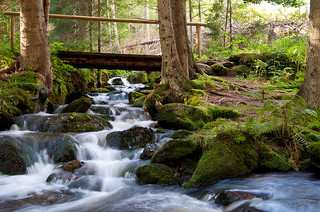Stepping back from the furnace to wipe your brow, you find yourself thinking about the Frenchman from Lyon who passed through town the other day. He spoke of his love of travel and how he hoped his trade stayed plentiful enough to avoid being tied to any one place for long. You couldn’t help but feel a little sad for the young man, adrift without structure or purpose. Or roots. Roots may keep a tree grounded, but they help you weather many storms.
Your parents were from here. Their parents were from here. Your wife was from the next village over. It’s not a bad life, really. It’s good, honest work, the demand is strong and you get to meet folks from faraway provinces. Yes, this life may not have the glamor of one those foreign cities, but it has its own charm here. Munich is only a few days travel if you wanted a city experience, and you don’t.
Yes, life may be rather tepid here for most, but the potash is rich, the forges are hot, and your rough worker’s hands never stay idle for long. Frankly, you wouldn’t have it any other way.
The Premise
Players take on the roles of Bavarian glass and brick makers during the period when the region was well-known for their advanced craftsmanship. Players must carefully manage their resources over several rounds as they seek to prove they are the best artisans around.
The Rules
Glass Road is largely a resource management Euro game with a twist. As in, this game has actual twistable dials. But we’ll get to that. Setup for the game varies slightly depending on the number of players, and players should consult the full rule book for variations.
Each player receives a Production board, a Landscape board, and a set of 15 Specialist cards. The Production board controls a player’s resources. Glass Road contains six basic resources (Quartz, Food, Charcoal, Water, Wood, and Clay), as well as the two advanced resources of Glass and Brick. One Production wheel tracks the manufacture of Glass; the other tracks Brick. Each player starts with the same basic resources.
The Landscape board denotes a player’s region. Throughout the game, players will be adding and removing various landscape tiles and buildings to their region.
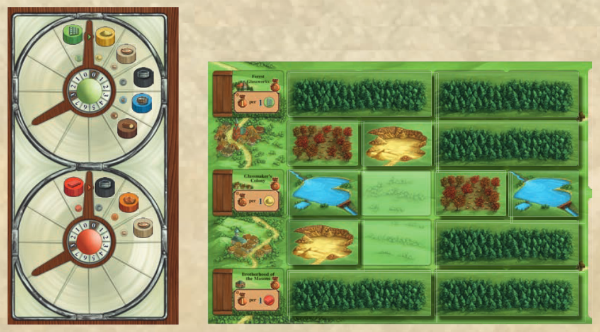
Each player’s starting boards, with the dials set to 8 o’clock.
There is also a central Building board, consisting of three rows of purchasable buildings. There are three building types in the game: Processing buildings (which let players convert resources at any time), Immediate buildings (generating one-time effects when built), and Bonus buildings (conferring VP at the end of the game).
Glass Road takes place over four rounds, called Building Periods, and each Building Period breaks down into three turns. At the beginning of each Building Period, players select five of their 15 Specialist cards. Each Specialist card has a top and bottom ability. These abilities allow players to gather resources, add landscape tiles, and/or construct buildings.
Acquiring resources in Glass Road consists of moving it up on the appropriate wheel. Should there ever be an empty space between a resource and the large hand, the dial moves. The result is a representation of the game’s thematic manufacturing process. That is, all its basic resources decrease when a wheel moves, but a player gains Glass or Brick in the process. Landscape and Building tiles by contrast are more straightforward. Tiles may be added to a player’s board simply by taking the right action and/or paying the requisite costs.
The starting player is determined randomly.
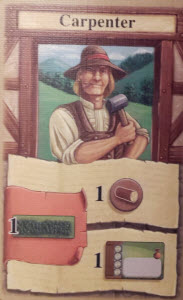
The Carpenter costs a Forest to use.
Each turn, players selects and places one of their five cards face-down. Then, the starting player reveals their card. If any other player has a matching Specialty card in their hand, they must also play their card at this time. (For example, if the revealed card was Fish Farmer, each player who had Fish Farmer in their hand also plays it.)
Each of those players then may choose one of the two abilities on that card and take that action. If no other player has a matching card, however, the revealing player may take both actions. Play then moves to the left of the last player who used a card. That player reveals their card, with others responding, and so on, until each player has chosen and revealed three cards in this way.
At the end of a Building Period, the starting player rotates and the buildings on the building board are restocked. Then a new Building Period begins.
The game ends after the fourth Building Period. At that point, the player with the highest VP score becomes the most renown artisan along the Glass Road of Bavaria.
Everyone else…well they probably go back to making more glass anyway. That’s all there really was to do there.
Don’t Judge A Book By Its Cover
Two things will undoubtedly jump out at you when you initially look at Glass Road. The first is the theme. With the ever-growing library of worthwhile games to hit your table, theme is often a deciding factor for many players. If two games are mechanically similar, whether you’re fighting space monster ghosts or commanding a highrise New York boardroom matter for enticing your audience.
So, when it’s explained that Glass Road is about making glass and brick, it’s not surprising there’s usually some immediate pangs of reservation.
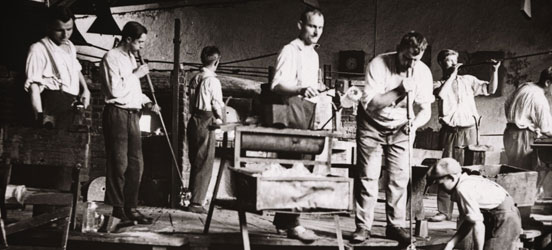
Fun fact: there was a Bavarian glassmaking operation all the way until 2009.
It’s no knock on the skill and artistry required by those traditional professions, but the subject likely won’t excite someone who has never played before. However, this should not stop someone from trying Glass Road. The theme may be a bit outside the realms of pirates, zombies, spaceships, and Lovecraftian horror, but Glass Road is as solid of a game as the bricks you’re making.
Glass Road is still a classic-style Euro game (where mechanics are the primary focus), but it does a fantastic job incorporating the theme through those mechanics. Players have an impressive array of options for a mid-level Resource Management game: Glass Road comes with 93 different possible buildings, though you may only see about a third per 4-player game. Yet its comprehensive rulebook explains every single one if needed. When paired with choosing from 15 different cards each round, the game easily proves to have far more variety and replayability than its humble theme suggests. Of course, that also means that there’s a slight learning curve to figuring out strategies in the game.
What’s more, while the artwork of the game is subtle and may quickly blend into the background of actual gameplay, inspection of the Specialist cards and buildings reveal that are actually well illustrated, adding to the game’s hidden richness.
That said, it still might not be enough for all Immersionists. Those who enjoy good world-building may find the basic-but-detailed Glass Road setting appealing, but those who seek narrative will not find it in these woods – as is the case with most games of this kind.
Taking A Spin Or Two
The other facet that catches players’ attention in Glass Road are the Production Wheels. This is how resources are managed, and it is the most unique part about the game, both in style and in function.
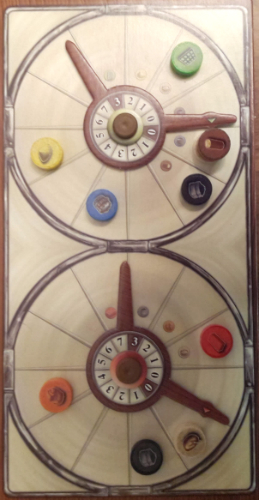
The player has 1 Glass at top. They would need Wood to get another.
Most resource games revolve around amassing stockpiles of resources to be used later, although many are known to add in checks or limits of some kind. Glass Road, however, has a much tighter control of goods. You can’t actually have more than seven of any basic resource per Wheel, and you’re limited to three glass and brick each.
It isn’t all that easy to maintain high numbers of resources anyhow – anytime you generate glass or brick, each other resource on that wheel is reduced by one. It’s a very flavorful and creative way to symbolize the manufacturing process of that good, as you’re expending some resources to make another. Still, don’t be surprised if it takes a little getting used to.
It also forces players to be very careful with their spending and acquisition of goods. Glass Road operates on small resource margins. You don’t want to waste time gathering resources you won’t use or lose when a wheel turns. Therefore, planning ahead is not just suggested – it’s a requirement. Because you’re selecting five cards at the beginning of the round, you’re effectively forced to plan three turns ahead.
Strategic planning is key in Glass Road, and there’s not a lot of room for extraneous purchases. These are magic words Tacticians love to hear, but with little space for unorthodoxy, it also means that Daredevils should skip this game. Strikers will have similar issues as well – there are so many paths to victory and little opportunity to do to block another player anyhow. Their only real combative move is to buy the building they believe another player wants, but unless it’s something they can also benefit from, it’s not going to help them achieve much in a scant four rounds. You know, like winning.
The one issue the wheel has isn’t even in function, but in form. Like classic game spinners, because of the way it’s assembled the board doesn’t sit flush on the table and, while minor, is an unfortunate ding to an otherwise splendid presentation.
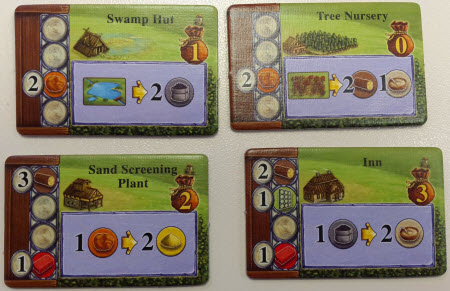
Who doesn’t want a good Swamp Hut?
Hidden Benefits
Another interesting but less obvious trait about Glass Road is that it has a social component. Since you normally only get to play three of your five cards a turn, the only surefire way to play the rest is to ascertain what other players will pick.
Much of the game revolves around improving your own Landscape board, but Glass Road differs from other non-interaction games because it rewards you for paying attention to what everyone else is doing. Extra cards provide you with more actions, as well as preventing your opponent from getting both of theirs.
This small aspect adds extra incentive for players to engage with one another on some level, and it’s an benefit for those who don’t want a true Tableau game. Regardless of this addition, Architects will highly enjoy resource gathering and strategically building out their Landscape board. That said, even with an hour or so of play time and mostly straightforward rules, Glass Road is still going to be far more complex than Socializers prefer in a game.
The Takeaway
In many ways, Glass Road behaves like a Worker Placement game without the workers. Players use the cards in their hands to generate the resources they need and the buildings they want while trying to figure out what everyone else is up to. Each player works diligently over the course of four short rounds, and the game will be over faster than you think. Between providing players with a load of in-game options while simultaneously remaining generally intuitive, Glass Road carves out a nice spot of being an intriguing and well-designed medium-length resource management game. It also scales well depending on the number of players. Sure, the rulebook could be streamlined somewhat, and it would be nice to see the spinner made flat. However, these are not major issues. The only minor gameplay hangups are occasional confusion over whose turn it is, and there’s a slight learning curve on strategy. Ultimately though, Glass Road proves to be far more inviting and engaging than its premise implies, and its theme permeates the entire game. Granted, it’s a theme that may not get many out of their chairs, but that’s quite alright: Glass Road works far better if you’re in them.
Glass Road is a product of Z-Man Games.
Cardboard Republic Snapshot Scoring (Based on scale of 5):
Artwork: 4
Rules Clarity: 4
Replay Value: 4
Physical Quality: 4.5
Overall Score: 4
Photo Credits: Glass Road cover and digital board by Z-Man Games; Glassblowers by Bavarian Forest National Park; Bavarian Scenery by skoeber.

